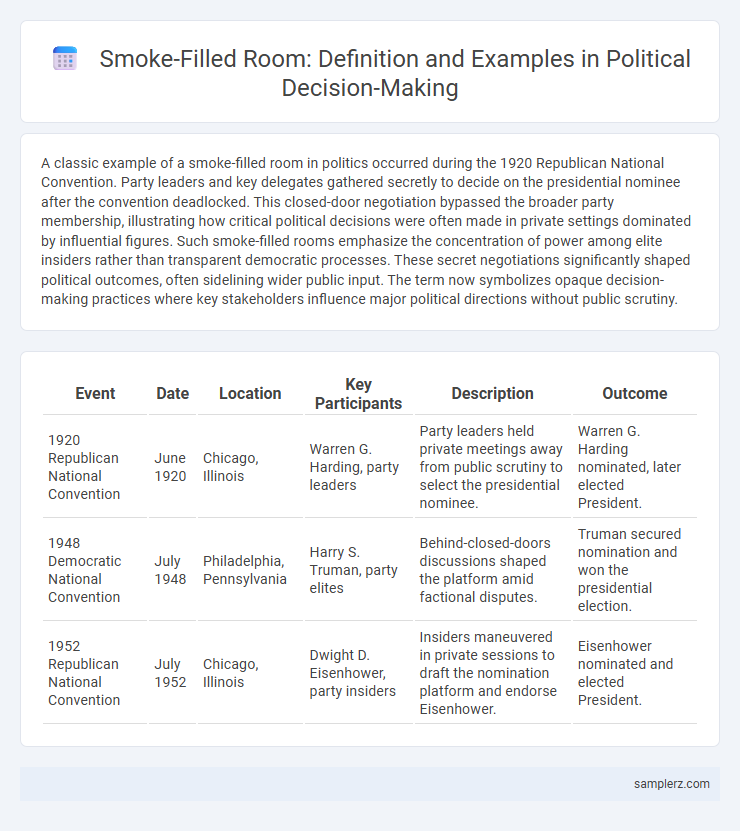A classic example of a smoke-filled room in politics occurred during the 1920 Republican National Convention. Party leaders and key delegates gathered secretly to decide on the presidential nominee after the convention deadlocked. This closed-door negotiation bypassed the broader party membership, illustrating how critical political decisions were often made in private settings dominated by influential figures. Such smoke-filled rooms emphasize the concentration of power among elite insiders rather than transparent democratic processes. These secret negotiations significantly shaped political outcomes, often sidelining wider public input. The term now symbolizes opaque decision-making practices where key stakeholders influence major political directions without public scrutiny.
Table of Comparison
| Event | Date | Location | Key Participants | Description | Outcome |
|---|---|---|---|---|---|
| 1920 Republican National Convention | June 1920 | Chicago, Illinois | Warren G. Harding, party leaders | Party leaders held private meetings away from public scrutiny to select the presidential nominee. | Warren G. Harding nominated, later elected President. |
| 1948 Democratic National Convention | July 1948 | Philadelphia, Pennsylvania | Harry S. Truman, party elites | Behind-closed-doors discussions shaped the platform amid factional disputes. | Truman secured nomination and won the presidential election. |
| 1952 Republican National Convention | July 1952 | Chicago, Illinois | Dwight D. Eisenhower, party insiders | Insiders maneuvered in private sessions to draft the nomination platform and endorse Eisenhower. | Eisenhower nominated and elected President. |
Defining the Smoke-Filled Room in Political Decision-Making
The smoke-filled room symbolizes a secretive gathering where political elites make critical decisions away from public scrutiny, often prioritizing power over transparency. This term originated from early 20th-century American politics, describing closed-door meetings that shaped party nominations and policy directions without voter input. Such clandestine decision-making processes highlight issues of accountability and democratic integrity within government institutions.
Historical Origins of the Smoke-Filled Room Concept
The term "smoke-filled room" originates from early 20th-century American politics, specifically the 1920 Republican National Convention where party leaders gathered privately to select the presidential nominee. This practice exemplified behind-the-scenes decision-making by elite insiders away from public scrutiny, often involving intense political negotiation and influence. The historical significance of the smoke-filled room highlights the tension between democratic transparency and concentrated political power within party hierarchies.
Classic Examples: U.S. Political Conventions and Backroom Deals
Classic examples of smoke-filled rooms in U.S. political decisions include the 1920 Republican National Convention where party leaders negotiated Warren G. Harding's nomination behind closed doors. These backroom deals often bypassed public opinion, consolidating power among political elites in small, private meetings. Such conventions highlighted the influence of party bosses and the lack of transparency in candidate selection processes.
Modern Political Scenarios Reflecting Smoke-Filled Room Tactics
Modern political scenarios often reveal smoke-filled room tactics through closed-door negotiations between party elites and lobbyists, sidelining public input and transparency. High-stakes decision-making during legislative bill drafting or cabinet appointments frequently occurs behind the scenes, reflecting centralized power dynamics. These practices undermine democratic accountability by concentrating influence among a select few rather than fostering open debate.
Key Players in Smoke-Filled Room Decisions
Key players in smoke-filled room decisions often include high-ranking politicians, senior advisors, and influential lobbyists who convene privately to shape policy outcomes without public scrutiny. These individuals leverage their insider status and networks to influence legislative agendas, appointments, or negotiations behind closed doors. Their decisions typically bypass transparency, prioritizing strategic interests over public debate.
Secrecy and Power Dynamics in Political Negotiations
Smoke-filled rooms symbolize clandestine political negotiations where secrecy limits transparency and centralizes power among a select few. These environments facilitate backdoor deals and strategic alliances, often excluding broader public or legislative input, thus intensifying power asymmetries. The lack of accountability inherent in smoke-filled room decisions undermines democratic principles and distorts policy outcomes.
Impact on Democratic Transparency and Public Trust
Smoke-filled rooms in political decision-making erode democratic transparency by concealing discussions from public scrutiny, undermining accountability. Such closed-door dealings foster public distrust as citizens perceive a lack of openness and potential corruption among elected officials. The diminished trust in political institutions often leads to voter apathy and weakened democratic engagement.
Famous International Cases of Smoke-Filled Room Politics
The 1940 Republican National Convention exemplified smoke-filled room politics when party leaders maneuvered behind closed doors to nominate Wendell Willkie as a compromise candidate. Another famous instance occurred during the 1979 Iranian hostage crisis, where secret negotiations between U.S. and Iranian officials bypassed public and legislative scrutiny. These cases highlight how exclusive, private discussions by political elites have historically shaped critical international decisions.
Reforms and Efforts to Prevent Backroom Decision-Making
Efforts to prevent backroom decision-making focus on promoting transparency through legislative reforms such as open-meeting laws and mandatory public disclosures. Establishing independent oversight bodies and encouraging citizen participation help reduce the influence of smoke-filled room politics. These measures aim to foster accountability and ensure decisions are made in an open, democratic environment.
The Legacy of Smoke-Filled Rooms in Contemporary Politics
The legacy of smoke-filled rooms endures in contemporary politics as secretive decision-making processes continue to influence power dynamics behind closed doors. These clandestine meetings often shape significant policy outcomes without public transparency, reflecting a persistent tension between democratic accountability and elite negotiation. Modern political scandals frequently expose how informal consultations, reminiscent of smoke-filled rooms, circumvent institutional checks and balances to consolidate influence.

example of smoke-filled room in decision Infographic
 samplerz.com
samplerz.com